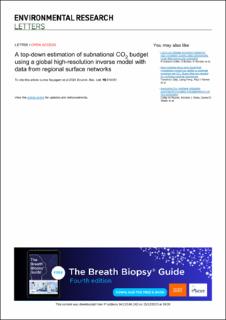| dc.contributor.author | Nayagam, Lorna Raja | |
| dc.contributor.author | Maksyutov, Shamil | |
| dc.contributor.author | Oda, Tomohiro | |
| dc.contributor.author | Janardanan, Rajesh | |
| dc.contributor.author | Trisolino, Pamela | |
| dc.contributor.author | Zeng, Jiye | |
| dc.contributor.author | Kaiser, Johannes | |
| dc.contributor.author | Matsunaga, Tsuneo | |
| dc.date.accessioned | 2023-12-18T14:03:33Z | |
| dc.date.available | 2023-12-18T14:03:33Z | |
| dc.date.created | 2023-12-15T10:24:38Z | |
| dc.date.issued | 2024 | |
| dc.identifier.citation | Environmental Research Letters. 2023, 19, 014031. | en_US |
| dc.identifier.issn | 1748-9326 | |
| dc.identifier.uri | https://hdl.handle.net/11250/3108052 | |
| dc.description.abstract | Top-down approaches, such as atmospheric inversions, are a promising tool for evaluating emission estimates based on activity-data. In particular, there is a need to examine carbon budgets at subnational scales (e.g. state/province), since this is where the climate mitigation policies occur. In this study, the subnational scale anthropogenic CO2 emissions are estimated using a high-resolution global CO2 inverse model. The approach is distinctive with the use of continuous atmospheric measurements from regional/urban networks along with background monitoring data for the period 2015–2019 in global inversion. The measurements from several urban areas of the U.S., Europe and Japan, together with recent high-resolution emission inventories and data-driven flux datasets were utilized to estimate the fossil emissions across the urban areas of the world. By jointly optimizing fossil fuel and natural fluxes, the model is able to contribute additional information to the evaluation of province–scale emissions, provided that sufficient regional network observations are available. The fossil CO2 emission estimates over the U.S. states such as Indiana, Massachusetts, Connecticut, New York, Virginia and Maryland were found to have a reasonable agreement with the Environmental Protection Agency (EPA) inventory, and the model corrects the emissions substantially towards the EPA estimates for California and Indiana. The emission estimates over the United Kingdom, France and Germany are comparable with the regional inventory TNO–CAMS. We evaluated model estimates using independent aircraft observations, while comparison with the CarbonTracker model fluxes confirms ability to represent the biospheric fluxes. This study highlights the potential of the newly developed inverse modeling system to utilize the atmospheric data collected from the regional networks and other observation platforms for further enhancing the ability to perform top-down carbon budget assessment at subnational scales and support the monitoring and mitigation of greenhouse gas emissions. | en_US |
| dc.language.iso | eng | en_US |
| dc.rights | Navngivelse 4.0 Internasjonal | * |
| dc.rights.uri | http://creativecommons.org/licenses/by/4.0/deed.no | * |
| dc.title | A top-down estimation of subnational CO2 budget using a global high-resolution inverse model with data from regional surface networks | en_US |
| dc.title.alternative | A top-down estimation of subnational CO2 budget using a global high-resolution inverse model with data from regional surface networks | en_US |
| dc.type | Peer reviewed | en_US |
| dc.type | Journal article | en_US |
| dc.description.version | publishedVersion | en_US |
| dc.rights.holder | © 2023 The Author(s). Published by IOP Publishing Ltd | en_US |
| dc.source.volume | 19 | en_US |
| dc.source.journal | Environmental Research Letters | en_US |
| dc.identifier.doi | 10.1088/1748-9326/ad0f74 | |
| dc.identifier.cristin | 2214021 | |
| dc.relation.project | NILU: 123081 | en_US |
| dc.source.articlenumber | 014031 | en_US |
| cristin.ispublished | true | |
| cristin.fulltext | original | |
| cristin.qualitycode | 2 | |

